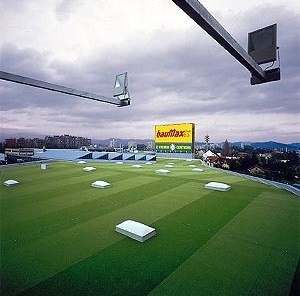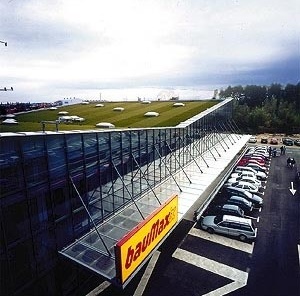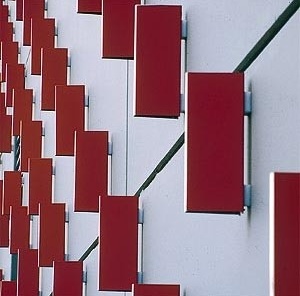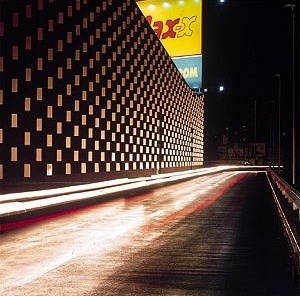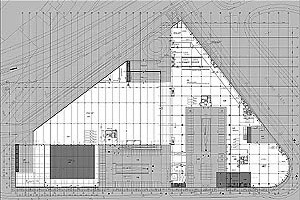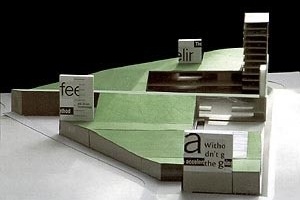An urban concept of reversing the figure / ground ratio of american hypermarkets. A celebration of traffic, performed by cutting the regular parking patterns into the irregular plot contour, should be strenghtened by the green roof substance, as a new elevated ground, publicly accessible. The negative reaction of developer turned the former concept into the new perceptual reality - no trespassing. The landscape is thus to be observed / mentally consumed / remote-controlled. The surreal nature of fireplace on the roof terrace of de Bestégui appartment by L-C is equaled by the virtual status of the landscaped zone in the Hypermarket.
All inward-bound planes are entirely glazed, all perimeter ones are mute, but user-friendly. A green roof as a common denominator and recreated artificial topography. Four billboards "anchor" the vast slopes of the House to the site and turn to the traffic streams.
Colour "classification" is an attempt to handle architecture by ordinary, if not banal, criteria - size, smell or colour. By assigning colour, as a consumption-profiled term to the projects, we are trying to resume the manifold facets and secret ambitions of every single one to an understandable and communicative platform, but also not to limit ourselves with a couple sizes. On the contrary, different shades of a single colour, could transmit even subtle expectations of particular design.
We think of a house in its natural appearance : wood is wood, brick is brick, concrete is concrete. Even the glazed elevations from the first façade concept exploited the properties of insulating wool as such. We used its yellowness as a part of the Baumaxx corporate identity, attaching simply the red logos onto it and blurring them slightly with corrugated polycarbonate sheets. Colour as a marketing strategy. In the theory of visual communications yellow and red are considered as "cheap", low-budget colours. That is why such D-I-Y markets use them.
Finally, the client rejected the solution in favour of prefab concrete panels. In order not to loose the impact of "active" elevations, it was decided to remain in the realm of readymades by choosing to put a layer of custom-made traffic reflectors in signal red and silver atop of concrete. The op-art effect is addressed to the drivers as major circulation force on the spot. Such a kinetic experience of the envelope - silver from the north, red from the south, neutral from the west, blends with the firm’s corporate colours . In the night the House turns to the pure Light.
Immediately after completion, the Slovenes "discovered" unparalleled similarity with the oeuvre of The Father. What came out of necessity to resolve the tensions of the site and objectives of the program, was suddenly seen as a blasphemous remake of Plecnik (the Church of The Holy Heart - Prague 1933). Should such a comparable design - in overall layout and formulation of the skin, really be prosecuted ? Although we had never considered it as referential to our project, the hints put forward by the high priests of the Plecnik religion, made us think. Isn’t a temple of christianity the right typological ancestor for the house of contemporary religion - that of consumerism ? What are parallels like - entrance Baumaxx panel / statue of St.Mary over main doors, or bell-tower / billboard, but a document of shifted social concerns - a transition from the spiritual to the material ? Couldn’t the Venturi-like semiotics testify of the similar system of signifiers, appropriated for the masses in general ? And finally - isn’t for a non-Slovene easier to terminate the Oedipal relation and "liberate" from the heavy load of the father-figure ? Furthermore, opening a public debate on a validity of architectural concepts in the current production, indicates a high level of concern of slovene cultural scene, as well as a capacity of the very building to provoke such intensities.
about the author
Helena Njiric (1963-) e Hrvoje Njiric (1960-) graduated at the Architecture School of the University of Zagreb, Croatia, and established a studio in 1996. Nowadays they are professors at the Architecture School of Graz, Austria.



